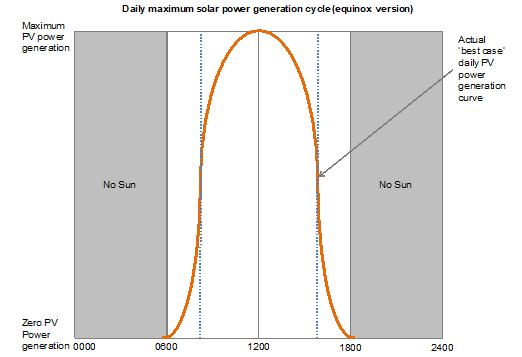
What does this diagram tell us? Remember, this is in a world where no fossil-fuel back-up power is available.
Let's call the area of the entire 24-hour rectangle our daily base-load requirement (24 hours times 100kW). The area under the orange bell curve is the actual solar panel electricity generated over a day. Obviously, this is much less than the required base-load dispatch (24 hours x 100kW).
Advertisement
Roughly, 12 hours of the day have no sun at all. For daylight hours, 6 hours on average have maximum sun. The remaining 6 hours have nothing on average.
Therefore, we need four times the effective solar panel generating capacity of a continuous fossil-fuel plant. Of its output, on average one-quarter is used as generated. Three-quarters must be stored for use when the sun is not shining (two-thirds of that) or when the sun is not shining strongly enough (the remaining third).
Compared with an old-style fossil-fuel generation capacity benchmark, we need seven times that capacity: four times as solar panel generation, and three times as storage of some sort. (This ignores all sorts of solar panel and storage efficiency losses.)
With 100% reliance on solar panels plus storage, per 100kWh dispatched, would such a power system be one-seventh,or less, of the cost of fossil-fuel base-load capacity? Don't think so right now. Yet this is what is required to make 100% solar plus storage cost-competitive with fossil fuels as a base-load energy source.
But wait: it's worse
This model is based on an equinox daily sun cycle. But using solar for base-load supply would require enough generation/storage capacity to cope with the least favourable sunlight days each year. These will vary by geographic latitude, but in all cases the winter solstice will be the target.
Advertisement
In the ACT at the winter solstice the day lasts about 9 hours and 47 minutes. The night is therefore about 14 hours and 13 minutes.
In this case, on our simplifying assumptions about clouds, fog, and light intensity, maximum solar generation capacity would average a bit under 5 hours, with a bit over 19 hours requiring storage. We need nearly five times the generation capacity of fossil-fuelled plant, plus nearlyfour times the storage capacity equivalent.
With 100% reliance on solar panels plus storage, per 100kWh dispatched, would such a power system be one-ninth,or less, of the cost of fossil-fuel base-load capacity? Don't think so right now. Yet this is what is required to make solar renewables cost-competitive with fossil fuels as a base-load energy source.
Discuss in our Forums
See what other readers are saying about this article!
Click here to read & post comments.
8 posts so far.